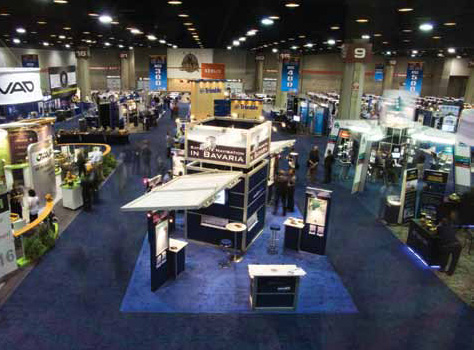 GPS Space Service Volume (SSV) Requirements/Performance Parameters
GPS Space Service Volume (SSV) Requirements/Performance ParametersNew space missions such as the robotic repair and recovery of damaged or errant communication satellites may become possible with the aid of an emerging class of receivers that is able to use GPS signals for navigation in orbits thousands of kilometers above the middle Earth orbit (MEO) GPS constellation itself.
New space missions such as the robotic repair and recovery of damaged or errant communication satellites may become possible with the aid of an emerging class of receivers that is able to use GPS signals for navigation in orbits thousands of kilometers above the middle Earth orbit (MEO) GPS constellation itself.
The receivers, largely pioneered by NASA, have been so successful the U.S. Air Force has stepped up to support this new application. The service has adopted specifications to ensure stable service for a growing contingent of high-orbit operations and even missions as far away as the moon.
The Air Force is not the only organization extending support. The United Nations’ International Committee on GNSS (ICG) has adopted a work item supporting implementation by other satellite navigation providers — an expansion that could greatly improve navigation at higher orbits for everyone.
Up to Now
Using GPS for space navigation is not new. For low Earth orbiting (LEO) spacecraft GPS receivers have become “pretty much standard” over the past 10 years,“ said Luke Winternitz, a navigation engineer at NASA’s Goddard Space Flight Center.
The receivers enable operators to reduce costs by limiting the need for expensive ground-based satellite tracking.
“It is like having a receiver on the ground,” said Winternitz. “With post processing they can get incredible accuracy with GPS.”
GNSS receivers are so useful that space agencies around the globe are incorporating them into their spacecraft. A NASA canvas of space agencies identified nearly 80 GPS-equipped missions that had either been launched or planned for launch, almost all of them since 2000, said Jim Miller, deputy director for policy and strategic communications in NASA’s Space Communications and Navigation program.
“Almost every mission is equipping to have some kind of GNSS receiver, either just GPS or a multi-GNSS receiver,” Miller told Inside GNSS.
What is new is the ability to employ GPS for missions operating at the very highest altitudes. New receivers that combine GPS signals and orbital dynamics can determine the location of satellites in geosynchronous orbits (GEOs), some 36,000 kilometers above the Earth, with an accuracy of around 100 meters. GPS satellite are in MEO orbits about 20,000 kilometers high.
Winternitz led the team that developed NASA’s Navigator receiver, a super-sensitive device optimized to acquire signals quickly. The receiver is the primary navigation sensor for NASA’s Global Precipitation Measurement Mission, which measures rain and snowfall, and the enabling navigation technology for NASA’s Goddard Space Flight Center’s Magnetospheric MultiScale (MMS) mission. MMS, which is to fly next year, comprises four identically instrumented spacecraft that will use the Navigator to fly in precise formation, while measuring the 3-D structure and dynamics of Earth’s protective magnetosphere from a very high-altitude Earth orbit.
The Navigator has an acquisition algorithm with significantly lower sensitivities than those of conventional space-based GPS receivers so that it can acquire signals at vast distances from the GPS constellation. According to a NASA paper, A GPS Receiver for Lunar Missions, the Navigator is able to acquire faint GPS signals down to a carrier-to-noise sensitivity between 22 and 25 dB-Hz.
Simulator tests indicate that the receiver could be useful during several different phases of a moon mission. During the return trip, tests show the Navigator could pick up a the main lobe of the GPS signal at as far away as 200,000 kilometers from Earth, and side lobe signals at 100,000 kilometers. This would sufficient to support one of the spacecraft’s first correction maneuvers at an altitude of 159,000 kilometers.
Making It Work
To perform such feats, designers of high-altitude receivers rely on the fact that not all of a GPS signal falls on the Earth’s surface. Some of each signal’s energy extends beyond the edge, or limb, of the planet.
To visualize this, imagine that you are standing in a driveway looking up at a streetlight. You pick up a basketball and hold it up in front of your eyes to block the light’s glare. It works but not all of the light is blocked. Some of the light is visible around the edges of the ball — just like some of a GPS signal leaks around the edge of the Earth. A satellite with a GPS receiver traveling through that bit of signal can pick it up and get useful information.
This also means a spacecraft on one side of Earth can pick up a signal slipping past the edge or limb of the planet from a GPS satellite on the opposite side of the Earth. The technique is limited because the Earth blocks most of any given signal, but with dozens of spacecraft in the GPS constellation and dozens of signals, a spacecraft can eventually pick up a side lobe from another GPS signal. The number of potential signals improves enormously if you can use those transmitted by other GNSS constellations.
Satellites can use this capability to navigate in a very high orbit. In fact, communications satellites in GEO orbits, which keep them over the same spot of the planet continuously, are able to use this technique.
“A lot of the commercial satellite providers are beginning to equip with GPS. And where are they located? They’re not in low Earth orbit — they’re in GEO,” said Miller. “So, when you look at where the commercial space sector is going, besides providing additional communications from GEO and so forth, we’re talking about future satellite servicing missions where you can literally have a robotic fix to your GEO satellite. So, it’s becoming more and more important to really know where that satellite is positioned using GPS for station keeping and other types of applications.”
Air Force Support
The technique only works as long as the signals from the GPS satellites are wide enough that some energy slips around the edge of the Earth. That is now assured. The Air Force has pledged to maintain the signals so that the area of space now reached by the GPS signals will be maintained as it is. That is a turnaround from where the Air Force was previously headed.
“What was happening,” said Miller, “was because they wanted to make GPS more efficient for most users, they thought ‘Hey, we’re tightening this beam width up so that more energy is focused on the Earth because the energy spilling over is wasted, no one’s using it.’” And we said ‘Wait a minute we are getting great utility out of that.’”
“We were able to demonstrate that this is very practical,” Miller added. “We just needed some level of guarantee so that, when they build future satellite blocks, we would know that they were at least going to be backwards-compatible and not harm the beam width or the power levels — things like that." Once they saw the benefits, “it was kind of a no-brainer.”
The Air Force has also adopted a set of specifications for the service that sets levels on pseudorange accuracy, received power, and signal availability. (See the tables for “GPS Space Service Volume Requirements/Performance Parameters”, inset photo, above right.)
“These space applications have been so successful (and so useful) that they have led to formal recognition of the space service volume (SSV) as a required extension of the down-to-Earth global (i.e., terrestrial) service volume,” confirmed a spokesperson with Air Force Space Command’s Space and Missile Systems Center.
The GPS Standard Positioning Service Performance Standard (SPS PS) [available here], defines the SSV as comprising the near-Earth region, which extends from an altitude of 3,000 kilometers above the surface of the Earth up to and including 36,000 kilometers above the Earth’s surface (e.g., for Geostationary Earth Orbit [GEO] satellites).
The Federal Radionavigation Plan (FRP), also available from that same web site, addresses the still evolving space user requirements for operation in the SSV as well as in the terrestrial service volume.
Proponents of space-based applications are now working to improve the navigation solutions and expand signal availability. Recently they convinced Lockheed Martin and the Air Force to release information on the antenna patterns of the GPS Block II and IIRM satellites. The data is available on-line here.
Knowing the antenna patterns will enable engineers to better understand the signals that will be available. They can design satellites to take maximum advantage of what’s there and get the best possible performance, explained Frank Bauer, a NASA consultant who helped develop ways to use GPS in upper orbits.
“Remember, we are relying on the remnants of signals that are spilling over the Earth,” Bauer told Inside GNSS. “Scientists and engineers try to eke as much out of the system as they can. If we can understand that better, we actually can get more —maximize the performance if you will.”
For example the antenna patterns quantify the antenna characteristics, including main and side lobe gain. Engineers can leverage those side lobes (the still-useful energy that trails off from the main signal) to improve availability.
“You can do studies about what your availability is and to estimate what your performance is going to be. It’s important to know the patterns,” agreed Winternitz. They can also indicate if there is some distortion of the signal that needs to be corrected for, he said.
Getting better navigation performance means better results. On the GOES-R weather satellite it means more accurate weather information, Bauer said. The GOES-R is the first spacecraft to use above-the-constellation navigation operationally.
So far Lockheed Martin is the only company to post antenna patterns.
“With more than a billion GPS users, the demand for GPS L-band civil signal data continues to grow, including from the space industry who use GPS to verify spacecraft navigation operations,” the company said in a prepared statement. “Lockheed Martin has been in a unique position to help as both the developer of the GPS IIR and IIR-M satellites — which represent more than 60 percent of the current GPS constellation — and having played a significant role sustaining these on-orbit systems for the U.S. Air Force for the last 17 years. The L-band broadcast antenna panel patterns data from these satellites was readily available, so Lockheed Martin coordinated with the Air Force for its public release to allow industry to take full advantage of this valuable data.”
Boeing did not respond to queries asking about the release of antenna patterns for the GPS IIF satellites. [Editor’s note: After publication of the original article, the company said in a prepared statement to Inside GNSS, “Boeing considers information relating to the antenna patterns to be sensitive for the GPS IIA and IIF fleet and constellation as a whole, and does not plan to publish it. Its publication would render the satellite signals more vulnerable to jamming and other interference. In addition, it is technical in nature and therefore subject to ITAR restrictions.”
Going Big
The next step, said Miller, is to improve the accuracy of above-the-constellation navigation by integrating signals from other satellite navigation constellations.
“At that [GEO] altitude,” said Miller, “you are only going to get coverage from one or two satellites at a time. However, if you build a multi-GNSS receiver for space, and the other PNT service providers also agree to have the space service volume, you’re most likely going to be able to plan missions where you’ll always have at least four (GNSS signals) in view and you are going to be able to get very accurate positioning 36,000 kilometers above the earth — which is quite impressive.”
It is possible to determine a satellite’s position with only the GPS system, Miller said, but the absolute position accuracy would be approximately 100 meters. Adding Galileo into the mix would bring two to three satellites in view at all times. Add in GLONASS, and four satellites would always be in view. BeiDou would add even more. A four-constellation combination would provide the best accuracy and onboard integrity, said Miller.
To be used together, the different PNT service providers need to adopt common definitions and specifications for use of GNSS signals within the space service volume.
In a presentation November 12 at the ICG meeting in Prague, Miller encouraged the delegations to participate by completing space service volume templates, developing specifications and publishing constellation antenna data.
The ICG has taken up the matter as a task for its Working Group B and, Inside GNSS has learned, they will be putting out information on the technique.
The subject appears to be drawing a great deal of interest. The Europeans, Russians, and Chinese all made presentations about high-orbit applications in Prague. The Europeans have done studies on the benefits of a GNSS approach to space navigation and said they “fully recognize the importance of an interoperable and GNSS SSV.” They should be done characterizing their space service volume by this spring, they said.
The Chinese are also working on the concept and have suggested that PDOP (position dilution of precision, a factor reflecting the multiplicative effect of satellite geometry on positioning accuracy) be added to the discussion. A Russian delegate made an interesting suggestion as well — adding an antenna at the back of GNSS satellites to broadcast a signal out into space.
It started with GPS, said Miller, but the other GNSS service providers have come to see that it is a really good idea.
“They know space is going to get busier and busier with a lot of commercial space launches and so everyone is working together to make it happen.”





